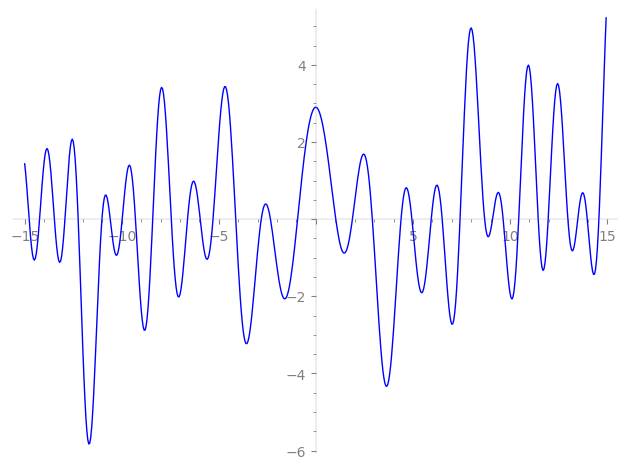| L(s) = 1 | + (7.33 + 4.23i)5-s + (1.94 + 3.37i)11-s − 19.1i·13-s + (−11.5 + 6.69i)17-s + (5.80 + 3.35i)19-s + (13 − 22.5i)23-s + (23.3 + 40.5i)25-s + 11.7·29-s + (31.6 − 18.2i)31-s + (16 − 27.7i)37-s − 20.9i·41-s + 79.2·43-s + (12.3 + 7.15i)47-s + (−6.89 − 11.9i)53-s + 33.0i·55-s + ⋯ |
| L(s) = 1 | + (1.46 + 0.847i)5-s + (0.177 + 0.307i)11-s − 1.47i·13-s + (−0.681 + 0.393i)17-s + (0.305 + 0.176i)19-s + (0.565 − 0.978i)23-s + (0.935 + 1.62i)25-s + 0.406·29-s + (1.02 − 0.590i)31-s + (0.432 − 0.748i)37-s − 0.511i·41-s + 1.84·43-s + (0.263 + 0.152i)47-s + (−0.130 − 0.225i)53-s + 0.600i·55-s + ⋯ |
\[\begin{aligned}\Lambda(s)=\mathstrut & 1764 ^{s/2} \, \Gamma_{\C}(s) \, L(s)\cr =\mathstrut & (0.982 - 0.188i)\, \overline{\Lambda}(3-s) \end{aligned}\]
\[\begin{aligned}\Lambda(s)=\mathstrut & 1764 ^{s/2} \, \Gamma_{\C}(s+1) \, L(s)\cr =\mathstrut & (0.982 - 0.188i)\, \overline{\Lambda}(1-s) \end{aligned}\]
Particular Values
| \(L(\frac{3}{2})\) |
\(\approx\) |
\(2.901287347\) |
| \(L(\frac12)\) |
\(\approx\) |
\(2.901287347\) |
| \(L(2)\) |
|
not available |
| \(L(1)\) |
|
not available |
\(L(s) = \displaystyle \prod_{p} F_p(p^{-s})^{-1} \)
| $p$ | $F_p(T)$ |
|---|
| bad | 2 | \( 1 \) |
| 3 | \( 1 \) |
| 7 | \( 1 \) |
| good | 5 | \( 1 + (-7.33 - 4.23i)T + (12.5 + 21.6i)T^{2} \) |
| 11 | \( 1 + (-1.94 - 3.37i)T + (-60.5 + 104. i)T^{2} \) |
| 13 | \( 1 + 19.1iT - 169T^{2} \) |
| 17 | \( 1 + (11.5 - 6.69i)T + (144.5 - 250. i)T^{2} \) |
| 19 | \( 1 + (-5.80 - 3.35i)T + (180.5 + 312. i)T^{2} \) |
| 23 | \( 1 + (-13 + 22.5i)T + (-264.5 - 458. i)T^{2} \) |
| 29 | \( 1 - 11.7T + 841T^{2} \) |
| 31 | \( 1 + (-31.6 + 18.2i)T + (480.5 - 832. i)T^{2} \) |
| 37 | \( 1 + (-16 + 27.7i)T + (-684.5 - 1.18e3i)T^{2} \) |
| 41 | \( 1 + 20.9iT - 1.68e3T^{2} \) |
| 43 | \( 1 - 79.2T + 1.84e3T^{2} \) |
| 47 | \( 1 + (-12.3 - 7.15i)T + (1.10e3 + 1.91e3i)T^{2} \) |
| 53 | \( 1 + (6.89 + 11.9i)T + (-1.40e3 + 2.43e3i)T^{2} \) |
| 59 | \( 1 + (-7.31 + 4.22i)T + (1.74e3 - 3.01e3i)T^{2} \) |
| 61 | \( 1 + (-27.4 - 15.8i)T + (1.86e3 + 3.22e3i)T^{2} \) |
| 67 | \( 1 + (-15.6 - 27.1i)T + (-2.24e3 + 3.88e3i)T^{2} \) |
| 71 | \( 1 + 95.5T + 5.04e3T^{2} \) |
| 73 | \( 1 + (15.8 - 9.15i)T + (2.66e3 - 4.61e3i)T^{2} \) |
| 79 | \( 1 + (39.8 - 69.1i)T + (-3.12e3 - 5.40e3i)T^{2} \) |
| 83 | \( 1 - 141. iT - 6.88e3T^{2} \) |
| 89 | \( 1 + (-100. - 58.2i)T + (3.96e3 + 6.85e3i)T^{2} \) |
| 97 | \( 1 - 137. iT - 9.40e3T^{2} \) |
| show more | |
| show less | |
\(L(s) = \displaystyle\prod_p \ \prod_{j=1}^{2} (1 - \alpha_{j,p}\, p^{-s})^{-1}\)
Imaginary part of the first few zeros on the critical line
−9.294537419201536814016105431670, −8.405821292224458153981732218377, −7.44915352919090069282778382890, −6.61208891113317350481306933286, −5.95933589711318349501501661816, −5.29955351175981169431224466660, −4.12982133864186660584883259571, −2.81497009317867984925968753254, −2.34152374075776061188122248568, −0.943725093609386939070907931512,
1.02352674527469370218644912802, 1.88105076923645374814005268833, 2.90606272389745228064310109459, 4.38592909015245386698391151885, 4.94456710564992803420751547032, 5.94144619112222820296808980745, 6.50423297091602723154575276989, 7.42512939398086888757396611615, 8.691362351417175749702885838589, 9.097892172896871639453112698980

